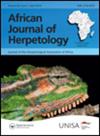Lack of phylogeographic structure in the endangered Pickersgill’s Reed Frog; Hyperolius pickersgilli (Raw, 1982)
IF 0.9
4区 生物学
Q3 ZOOLOGY
引用次数: 2
Abstract
ABSTRACT The Endangered Pickersgill’s Reed Frog (Hyperolius pickersgilli) is endemic to South Africa and restricted to the KwaZulu-Natal (KZN) coast. The natural habitat of H. pickersgilli is limited to fragmented patches of coastal reed-bed wetland, the majority of which continues to undergo transformation and degradation caused by urbanisation, agriculture, mining and forestry. These changes have resulted in the steady reduction of suitable, quality habitat and severe fragmentation. In the current study we employed mitochondrial DNA and species-specific microsatellites markers (developed in the current study) to investigate the genetic structure and diversity of H. pickersgilli. Genetic markers revealed moderate to high levels of genetic diversity throughout the remnant groups and absence of specific phylogeographic structure among individuals sampled across twelve localities throughout the range of the species. Results from the current study indicate that gene flow between H. pickersgilli individuals is not restricted, whereby neighbouring groups may interact with each other through continued migration, thereby facilitating possible range expansion should habitat be available. However, the need for continued conservation of the H. pickersgilli population through the protection and management of its natural habitats should remain a top priority in order to conserve representative levels of genetic diversity.濒临灭绝的皮克斯吉尔苇蛙缺乏系统地理结构;皮氏Hyperolius pickersgilli(生,1982)
摘要:濒临灭绝的皮克斯吉尔苇蛙(Hyperolius pickersgilli)是南非的特有种,仅限于夸祖鲁-纳塔尔(KZN)海岸。H.pickersgilli的自然栖息地仅限于零散的沿海芦苇床湿地,其中大多数湿地仍在经历城市化、农业、采矿和林业造成的转型和退化。这些变化导致了适宜的优质栖息地的不断减少和严重的破碎化。在当前的研究中,我们使用线粒体DNA和物种特异性微卫星标记(在当前研究中开发)来研究H.pickersgilli的遗传结构和多样性。遗传标记显示,在整个物种范围内的12个地点取样的个体中,整个残余群体的遗传多样性处于中等至高水平,并且缺乏特定的系统地理结构。目前的研究结果表明,H.pickersgilli个体之间的基因流动没有受到限制,因此相邻群体可以通过持续迁徙相互作用,从而在有栖息地的情况下促进可能的范围扩大。然而,需要通过保护和管理其自然栖息地来继续保护H.pickersgilli种群,这仍然是一个首要任务,以保护具有代表性的遗传多样性水平。
本文章由计算机程序翻译,如有差异,请以英文原文为准。
求助全文
约1分钟内获得全文
求助全文
来源期刊

African Journal of Herpetology
ZOOLOGY-
CiteScore
3.00
自引率
6.70%
发文量
15
审稿时长
>12 weeks
期刊介绍:
African Journal of Herpetology (AJH) serves as an outlet for original research on the biology of African amphibians and reptiles. AJH is an interdisciplinary journal that publishes original articles and reviews from diverse fields and disciplines, such as conservation, phylogenetics, evolution, systematics, performance, physiology, ecology, behavioural ecology, ethology, and morphology.
The Journal publishes two issues a year. There are no page charges .
 求助内容:
求助内容: 应助结果提醒方式:
应助结果提醒方式:


